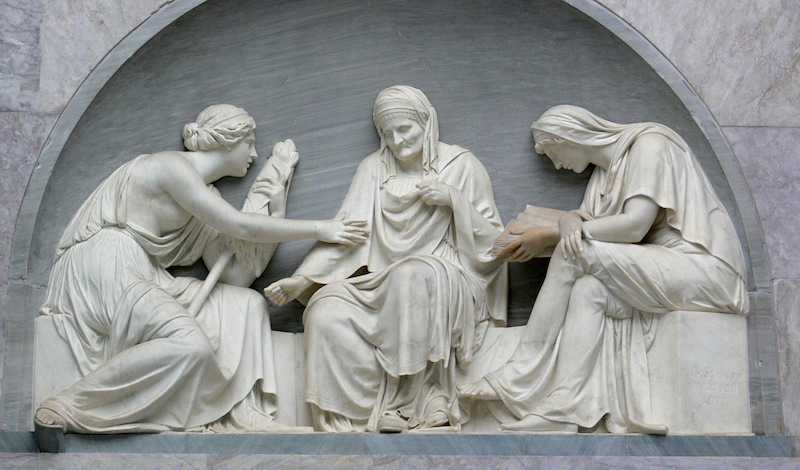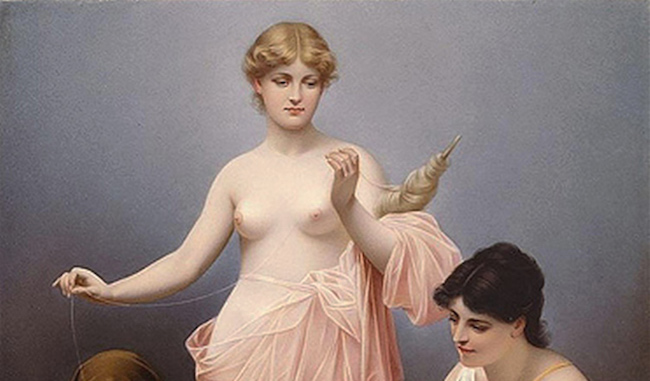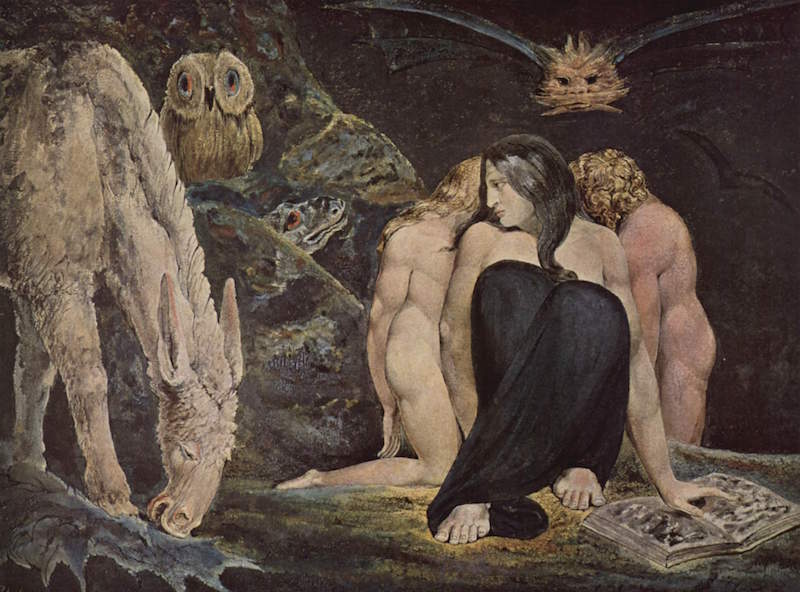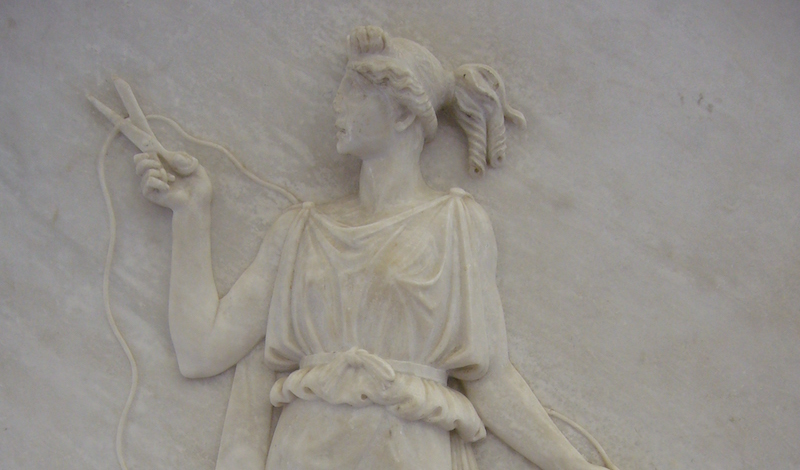In Greek mythology, the Three Fates are a triad of goddesses who dictate human destiny. Weirdly, they make great recurring villains in RPGs!
Classically, the three fates are depicted as three women of three different ages: maiden, mother, and crone (a common motif). Together, they weave the thread of each mortal’s destiny. The first, Clotho, spins the thread. The second, Lachesis, measures it. And the third, Atropos, cuts it. When the thread of a mortal’s life comes to an end, he will die. The Fates are independent of the other gods. In the Iliad, even Zeus must defer to their decisions. They are clearly not to be trifled with.

Because the Three Fates exist outside the normal hierarchy of the gods, they’re easy to drop into any setting with a pantheon of gods. Don’t feel beholden to doing the Three Fates as three fates. Even in ancient Greece, there were numerous interpretations of the goddess of fate. In the Odyssey, Fate is depicted as a single goddess accompanied by nameless spinners. Sometimes the Fates were ugly old women. Sometimes, Clotho was young and beautiful, Lachesis mature, and Atropos aged and severe. One of my favorite versions conflates the Fates with the Graeae, three aged witches who share a single eye and a single tooth, which they must pass between them. In some stories, the Fates appear after a child is born to dictate his destiny. In other stories, they don’t.
You can make a great comparison with the Batman universe. Jack Nicholson, Heath Ledger, and Mark Hamill all play the Joker as a distinctly different characters. Yet we have no difficulty identifying all of them as the Joker, and we don’t see any contradiction. In much the same way, the Greeks had a lot of conflicting stories about their gods, but they didn’t see that as a problem.
The point is, the Greeks didn’t agree on what the Fates looked like, or how many there were. If you want to change the Fates to better fit your campaign setting, you should feel empowered to do so.

What makes the Three Fates so fun in a gaming context is their potential as recurring villains for a particular kind of gaming group. You remember the kind of group we all played in when we were teenagers? When we deliberately played our characters as unpredictable, zany, or unintentionally psychotic? RPGs were an opportunity to cut loose, violate social mores, and not suffer the consequences. That’s not limited to childhood. Most of my campaigns are ‘serious’, but I play in a monthly D&D game that still has that vibe.
The Three Fates are perfect recurring villains for that kind of party. These mischievous PCs are agents of chaos, so who better to oppose them than the embodiments of destiny? Every few sessions, the Three Fates send aspects, avatars, or minor manifestations of themselves to oppose the PCs’ plans, and the party can have a good time overcoming this obstacle. Using the Three Fates as villains acknowledges the party’s actions but doesn’t penalize them. It lets you flag in-world that your PCs are effectively agents of chaos (nobody else has the Three Fates chasing after them), but it doesn’t stop the fun by throwing the PCs in jail or killing them.

Using the Three Fates as villains also has this wonderful symbolic nature to it. It’s ‘meta’, if you want to be hipper than I am. In most systems, the only characters with free will are the PCs. Anything the PCs don’t affect happens according to the whims of an all-powerful force (the GM). If you add the goddesses of destiny to your setting, the PCs are the only beings they can’t control. This is particularly true of unpredictable parties that rampage across the countryside, spreading chaos as they go. Small wonder the Fates are aghast at these beetles, gnawing holes in their perfect tapestry. The Fates don’t even have to be the primary villains. You can keep the PCs focused on the Big Bad Evil Guy, but every so often, have the Fates drop in to oppose the only characters in the story with agency.
Perhaps the Three Fates send avatars to oppose the PCs’ schemes. These minor incarnations, which can be fought and beaten by the party, may recruit henchmen to further their schemes. They may promise changes to NPCs’ fates in exchange for service. Are the Fates true to their word? Is the promise of fate always certain? Or are they duplicitous, unwilling to change their perfect tapestry even for their loyalest pawns?

How you stat up your Avatars of the Fates for combat depends on your system, of course. Here’s a few options.
Clotho:
– Wields the thread of life like a garrote.
– If she hits her target, she can choose to spend an action point. The target must either spend an action point or be bound on his next turn.
– If one of Clotho’s allies is injured, she can re-spin their thread of life mid-combat, healing them for an amount of damage appropriate to the system. Wounds appear stitched with a thread of the same color as Lachesis’ garrote. Missing limbs are replaced by simulacra of crocheted or knotted thread.
Lachesis:
– Wields a measuring rod. It plunges into flesh like a dagger into water.
– Can see the future (though her ability to foresee the PCs’ actions is limited), increasing her dodge bonus against attacks.
– Can re-measure someone’s life mid-combat. She can always spend an action point to force a die to be rerolled.
Atropos:
– Wields her dread shears. Even when she misses, she still deals a small amount of damage.
– Has tougher stats than her sisters, reflecting her grave reputation.
– Being an avatar of inexorable death means she cannot conceive of being resisted. Whatever tactics the PCs use against her are likely to work. No matter how many times the PCs thwart her, she simply cannot imagine someone successfully opposing her.
–
The image of Atropos is by Tom Oates. It’s released under a Creative Commons Attribution-Share Alike 3.0 Unported license.






